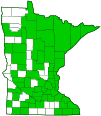potter and mason wasps
(Ancistrocerus spp.)
Overview • Description • Distribution • Taxonomy
Description |
||
Ancistrocerus wasps are black with yellow or white markings. The front and rear parts of the body are joined without a long petiole. On most species the body is hairy. The head, the front part of the body (mesosoma), and the first two segments (T1 and T2) on the rear part of the body (metasoma) have dense long hairs. T1 is much wider than long and is slightly narrower than T2. It has a transverse ridge (carina) that separates the rear portion from the sloped front portion. The antennae on the male are hooked and pointed at the end. This is the feature that gives the genus its scientific name. Ancistrocerus means “hooked horn”. However, this feature is shared with most other genera of potter wasps. |
||
Distribution |
||||
|
Sources |
|||
| 11/16/2022 | ||||
Taxonomy |
|||
Order |
Hymenoptera (Ants, Bees, Wasps, and Sawflies) | ||
Suborder |
Apocrita (Narrow-waisted Wasps, Ants, and Bees) | ||
| No Rank | Aculeata (ants, bees, and stinging wasps) | ||
Superfamily |
Vespoidea (vespoid wasps) | ||
Family |
Vespidae (hornets, paper wasps, potter wasps, and allies) | ||
Subfamily |
Eumeninae (potter and mason wasps) | ||
Subordinate Taxa |
|||
bramble mason wasp (Ancistrocerus adiabatus) Catskill potter wasp (Ancistrocerus catskill) curved mason wasp (Ancistrocerus spilogaster) European tube wasp (Ancistrocerus gazella) lobed mason wasp (Ancistrocerus antilope) milky potter wasp (Ancistrocerus albolacteus) one-banded mason wasp (Ancistrocerus unifasciatus) smiling mason wasp (Ancistrocerus campestris) stripe-bellied mason wasp (Ancistrocerus lineativentris) Walden’s potter wasp (Ancistrocerus waldenii) wall mason wasp (Ancistrocerus parietum) white-banded potter wasp (Ancistrocerus albophaleratus) yellow ab wasp (Ancistrocerus tuberculocephalus) |
|||
Synonyms |
|||
Ancistocerus |
|||
Common Names |
|||
This genus has no common name. The common name of the Subfamily Eumeninae is potter and mason wasps, and it is used here for convenience. |
|||
Glossary
Carina
An elevated keel or ridge.
Mesosoma
In Hymenoptera: the front part of the body, consisting of all three segments of the thorax and the first segment of the abdomen, to which the wings are attached.
Metasoma
In Hymenoptera: the armored rear part of the body, consisting of the second segment of the abdomen and all segments posterior to it.
Petiole
On plants: The stalk of a leaf blade or a compound leaf that attaches it to the stem. On ants and wasps: The constricted first one or two segments of the rear part of the body.
Visitor Photos |
|||||
Share your photo of this insect. |
|||||
| This button not working for you? Simply email us at info@MinnesotaSeasons.com. Attach one or more photos and, if you like, a caption. |
|||||
Babette Kis |
|||||
Ancistrocerus sp. potter and mason wasps |
|||||
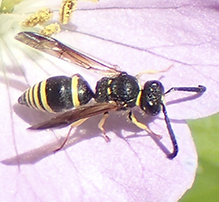 |
|||||
Alfredo Colon |
|||||
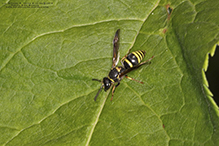 |
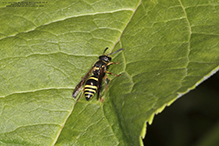 |
||||
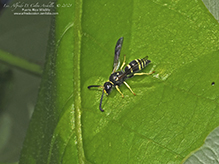 |
|||||
MinnesotaSeasons.com Photos |
|||||
|
|||||

Slideshows |
||
| Ancistrocerus Iyptala's Garden |
||
 |
||
About
Le genre ancistrocerus sont des guêpes solitaires qui utilisent de la boue pour former les paroies des alvéoles qu'elle construit pour y déposer ses larves. C'est pourquoi on les nomme aussi des guêpes maçonnes. Elle utilise un trou dans un arbre, une fissure dans une pierre, un trou dans le sol, ou autre pour y installer son nid. La femelle y dépose ensuite des insectes paralysés qu'elle capture afin de servir de nourriture à sa larve. Après la reproduction, la guêpe ne pond qu'une quantité limitée d'oeufs qui varie selon l'espèce. Une fois la ponte terminée, elle arrête la construction de cellules et meurt. Google Translate: The genus ancistrocerus are solitary wasps that use mud to form the walls of the cells it builds to deposit its larvae there. This is why they are also called mason wasps. It uses a hole in a tree, a crack in a stone, a hole in the ground, or other to install its nest. The female then deposits paralyzed insects there, which she captures in order to serve as food for her larva. After reproduction, the wasp lays only a limited amount of eggs which varies depending on the species. Once spawning is complete, she stops building cells and dies. |
||

Visitor Videos |
|||
Share your video of this insect. |
|||
| This button not working for you? Simply email us at info@MinnesotaSeasons.com. Attach a video, a YouTube link, or a cloud storage link. |
|||
Other Videos |
|||
| Ancistrocerus (Vespidae) Hymenoptera of North America |
|||
About
Aug 13, 2021 This video is intended to assist those who are looking to identify hymenopteran specimens or for anyone who wants to familiarize themselves with the order. female Ancistrocerus antilope: male Ancistrocerus antilope: female Ancistrocerus catskill: male Ancistrocerus catskill: female Ancistrocerus adiabatus: male Ancistrocerus adiabaus: female Ancistrocerus unifasciatus: male Ancistrocerus unifasciatus: This is the first video of this series. This genus is special to me because It was the focus of my graduate studies. Therefore, due to its primary role, I would like to dedicate this video to my loving wife, Clarissa Lynch. No one has assisted me more (in my scheme to take over the role now held by Edwin O. Wilson as world's most important naturalist) in my benevolent endeavors. Clarissa has been patient and supportive of my entomological interests for many years. Thank you my love, for your support and for the encouragement you give me every day. |
|||

Visitor Sightings |
|||||
Report a sighting of this insect. |
|||||
| This button not working for you? Simply email us at info@MinnesotaSeasons.com. Be sure to include a location. |
|||||
| Alfredo Colon 5/31/2021 |
Location: Woodbury, MN |
 |
|||
| Babette Kis 5/29/2021 |
Location: Barnes Prairie, Racine Co., WI |
 |
|||
| Alfredo Colon 8/15/2019 |
Location: Woodbury, MN |
 |
|||
MinnesotaSeasons.com Sightings |
|||||
|
|||||

Created: 11/16/2022
Last Updated:
